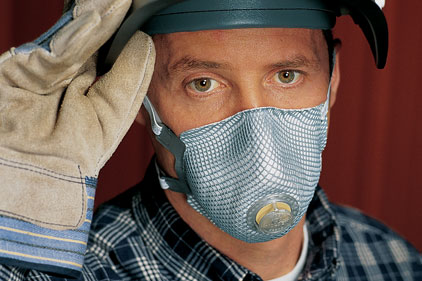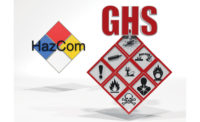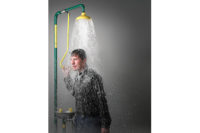According to OSHA, an estimated five million workers are required to wear respirators in 1.3 million workplaces throughout the United States.
The primary objective of a company’s respiratory protection program is to prevent excessive exposure to occupational air contaminants and oxygen deficiency. When effective engineering controls and work practice control measures are not feasible, or while they are being implemented or evaluated, respiratory protection may be required to achieve this objective.
| Respiratory protection elements |
Respiratory protection program elements
Employers must include the following procedures in the program:
- Proper respirator selection
- Medical evaluations of affected employees
- Fit-testing procedures for tight-fitting respirators
- Proper use of respirators in routine and reasonable foreseeable emergency situations
- Schedules and procedures for cleaning, disinfecting, storing, inspecting, repairing, discarding, and otherwise maintaining respirators
- Methods for ensuring adequate air quality, quantity, and flow of breathing air for atmosphere-supplying respirators
- Training of employees regarding the respiratory hazards that they may be potentially exposed to during routine and emergency situations
- Training of employees in the proper use of respirators – donning and doffing, any limitations on their use, and maintenance, and
- Regular evaluations of the respiratory protection program
Evaluating respiratory hazards
OSHA requires employers to evaluate respiratory hazard(s) in the workplace (contaminant and concentration), identify relevant workplace and user factors, and base respirator selection on these factors. The respiratory hazard evaluation includes “a reasonable estimate of employee exposures to respiratory hazard(s)”.
The respirator type or class is then selected by comparing the employee’s exposure to the occupational exposure limit and determining the minimum necessary respirator assigned protection factor. When an employer cannot identify or reasonably estimate employee exposure, OSHA requires employers to consider the atmosphere as “immediately dangerous to life and health” (IDLH).
Medical evaluation
The medical evaluation is designed to identify medical conditions that place employees who use respirators at risk of serious medical consequences.
Medical evaluation of employees is required for mandatory use of all respirators and for voluntary use of elastomeric facepieces. Employees must be medically evaluated and found eligible to wear the selected respirator prior to fit testing.
Fit-testing
29 CFR 1910.134(f) states: “This paragraph requires that, before an employee may be required to use any respirator with a negative or positive pressure tight-fitting facepiece, the employee must be fit tested with the same make, model, style, and size of respirator that will be used.”
The primary purpose of fit testing is to identify the specific make, model, style, and size of respirator best suited for each employee. In addition, fit testing reinforces respirator training by having employees review the proper methods of donning, wearing and doffing the respirator.
Fit testing must be performed before an employee first starts wearing a respirator in the work environment or whenever a different tight-fitting facepiece is used, and at least annually thereafter.
Respirator use
All respirators used must be certified by the National Institute for Occupational Safety and Health (NIOSH). Under certain conditions, OSHA may permit the use of respirators not approved by NIOSH (where no NIOSH-approved respirator exists) when documentation exists to attest to the adequacy of the respirator’s effectiveness against the contaminant(s) of concern.
For protection against gases and vapors in non-IDLH atmospheres, air-purifying respirators with the appropriate cartridge/canister may be selected. When selected, a system must be in place that reliably protects the user from contaminant breakthrough. The cartridge/canister must either be equipped with a NIOSH-approved end-of-service life indicator (ESLI) or if there is no ESLI, then the established cartridges/canister change schedule must be followed (29 CFR 1910.134(d)(3)(iii)(B)(2). If there is no ESLI or established change schedule, an air-supplying respirator must be used.
For protection against particulates in non-IDLH atmospheres, an air-purifying respirator equipped with filters certified for particulates by NIOSH as stated in 42 CFR Part 84 may be selected. Filters should be replaced when the breathing resistance becomes great enough to cause discomfort, when the filter is physically damaged or in accordance with the specific manufacturers’ instructions.
All filters, cartridges and canisters are to be labeled and color-coded with the NIOSH approval label. This label must not be removed and must remain legible.
Maintenance and care
In addition to OSHA maintenance and care requirements, the respirator manufacturer’s instructions for inspecting, cleaning, and maintaining should be consulted. All maintenance and care programs must include at least cleaning and disinfecting procedures, proper storage, regular inspections for defects, and repair methods.
Training
At a minimum training must cover the following:
- General requirements of the OSHA Respiratory Protection Standard
- Identification of the hazards involved, the extent of employee exposure to the hazards and the potential health effects of such exposures — the training required by OSHA’s Hazard Communication Standard (29 CFR 1910.1200) meets this requirement
- Proper selection of respirators
- Procedures for inspecting the respirator(s), donning and doffing, checking the fit and seal and wearing the respirator(s)
- Discussion of the consequences of improper fit, usage or maintenance
- Capabilities and limitations of the respirator(s) including discussion of ESLI and/or cartridge/canister change schedules
- Using the respirator(s) in emergency situations
- Maintenance and storage procedures
- Recognizing medical signs and symptoms that may limit or prevent effective respirator use
Retraining should be done annually, or under some conditions, sooner. Retraining is necessary, for instance, when changes in the type of respirator assigned render previous training obsolete, or when an employee has not retained the understanding or skill to use the respirator properly.
Program evaluation
A respiratory protection program administrator is designated by the employer and is qualified by appropriate training or experience. He/she must conduct evaluations of the respiratory protection program to ensure continued program effectiveness. Evaluations determine whether correct respirators are being used and worn properly and whether the training program is effective.
Voluntary use
For situations where respirators are not required, but are permitted by employers if requested by employees, employers may allow voluntary use if the respirator use will not in itself create a hazard. Check OSHA’s respiratory protection standard for the criteria for voluntary usage.



